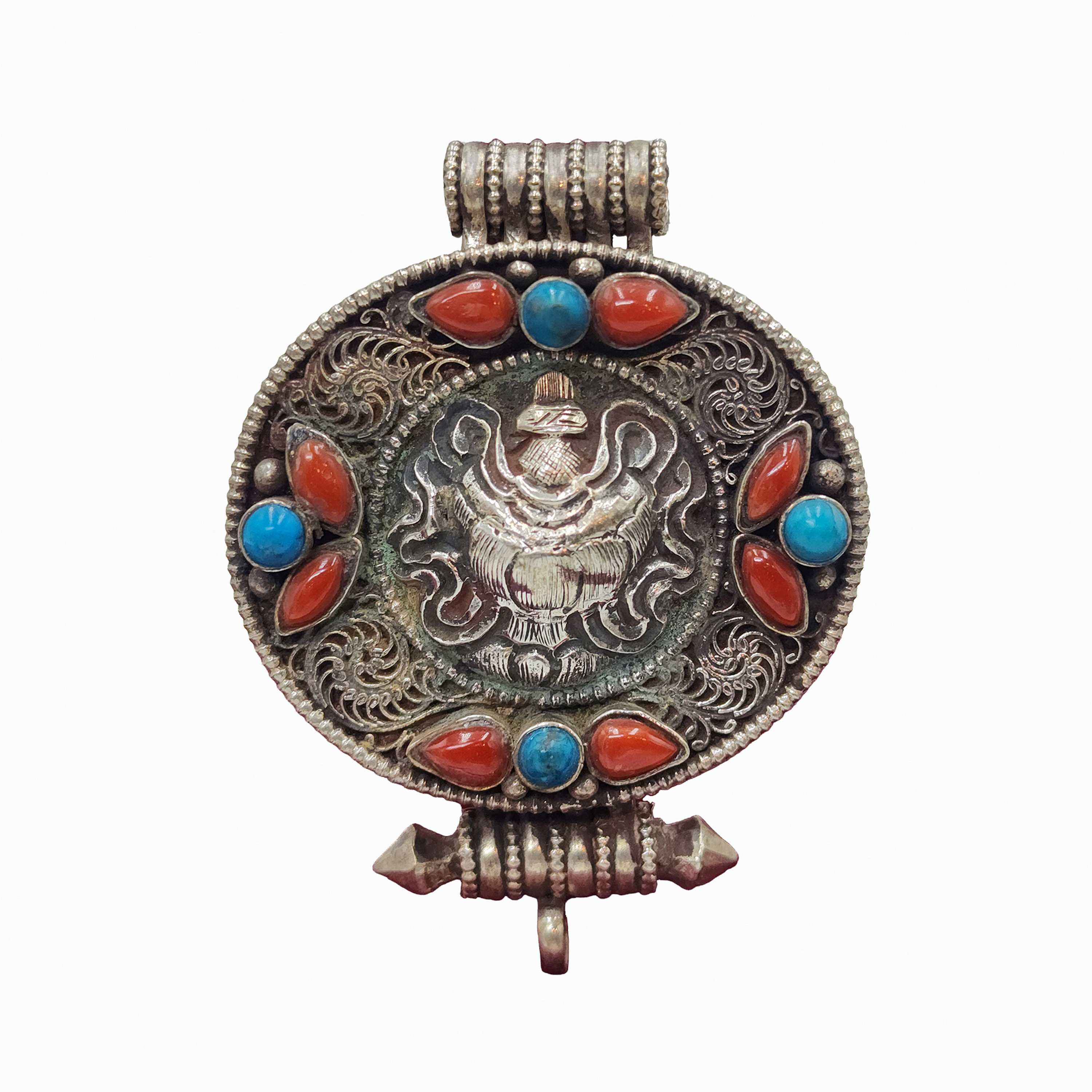Ghau
Ghau is a portable shrine in which an image of the owner's personal deity (Ishta Devata) is kept wrapped in silk cloth. Most Tibetans used Ghau at home and during traveling. At home, it is kept on alter but when traveling it is fastened at the cross belt. Generally, Ghau has trefoil shapes to and a window in the middle through which one can see the personal deity. Ghau is made of two parts which fit together to form a box. The back is usually left plain and the front is richly decorated.
Read More
Purna Kalash : Brief Introduction
Poorna Kalash is a water vase which is full of all the characteristics of goodness as it is full of all goodness. It is treated as an auspicious object for all human beings. When the religious ceremonies are held Poorna Kalash is kept ate the centre surrounded by eight vessels. In Poorna Kalash, there will be the signs of eight auspicious symbols
The Kalasha is included in the Ashtamangala lists of both the Svetambara and Digambara sects of Jainism. Two eyes are depicted around the Kalasha, symbolising right faith and right knowledge. It is used for religious and social ceremonies. It is used in temples when certain images are being worshipped. When one enters a new home it is customary to carry the kalasha on the head reciting mantras. This ceremony is performed to welcome grace and happiness into the new home. They first appear in stone in the Kushan Empire period (65-224 AD). It is a symbol of auspiciousness.
Finishing: Stone Setting
The Ghau is adorned with an exquisite array of semi-precious stones, including turquoise, coral, and lapis lazuli. These stones are carefully selected and meticulously placed on the Ghau's surface, adding a touch of opulence and enhancing its overall beauty. Each stone is thoughtfully positioned using a high-quality adhesive, ensuring secure and long-lasting attachment. The vibrant colors and unique patterns of the stones create a captivating contrast against the backdrop of the Ghau, elevating its visual appeal and making it truly eye-catching.
Beyond their decorative purpose, these semi-precious stones carry symbolic significance in various cultures and traditions. Turquoise is often associated with protection and healing, coral represents vitality and passion, while lapis lazuli symbolizes wisdom and truth. The inclusion of these stones not only adds to the aesthetic allure of the Ghau but also imbues it with deeper meaning and cultural symbolism.
The intricate placement of these semi-precious stones showcases the meticulous craftsmanship and attention to detail that goes into the creation of the Ghau. It is a testament to the skill and artistic vision of the artisans who delicately adorn the statue, resulting in a truly remarkable and captivating piece of art.
Read More
What is Seku Desing
Seku is a traditional Newari craftsmanship technique that involves the use of thin metal wire, typically copper or silver, to create intricate patterns on various objects. The word "Seku" is derived from the Newari language, and is commonly used to refer to this type of craftsmanship. This technique is a prominent aspect of Newari art and has been passed down through generations of artisans.
The process of creating Seku designs involves carefully shaping and molding the metal wire into various patterns. This can include simple geometric shapes or more complex, detailed designs. The wire is then carefully placed onto the surface of the object, where it is secured in place. The final result is a beautiful and intricate design that showcases the skill and precision of the artisan.
Seku craftsmanship can be found on a variety of different objects, including traditional Newari jewelry, home decor, and even architectural elements. The technique is often used to add decorative touches to objects that are already rich in cultural significance, such as statues of deities and other religious artifacts. The intricate and detailed nature of the craftsmanship makes it highly valued and respected within the Newari community, and it continues to be an important aspect of their cultural heritage.
Read More
Silver Plated
The Ghau has a full Silver plated finish, Sliver plating process involves the application of a thin layer of genuine silver onto the surface of the Ghau, creating a stunning and lustrous appearance. Skilled artisans handle the silver plating, ensuring even coverage and a flawless finish. The silver plating adds a touch of elegance and sophistication to the Ghau, enhancing its overall aesthetic appeal.
WHAT'S THE SILVER PLATING PROCESS?
Silver plating is valued for its durability and ability to resist tarnishing, allowing the Ghau to maintain its radiant shine for an extended period. The silver-plated finish also offers versatility, complementing various design styles and adding a touch of refinement to any setting.
By choosing the Ghau with a silver plated finish, you can enjoy the timeless beauty and allure of silver, creating an exquisite and eye-catching piece that is sure to captivate.
The silver plating process steps are relatively straightforward, although they differ depending on what type you're doing — barrel or rack plating. The basic strategy, however, goes like this:
Inspection: Before electroplating, you should always check the part for imperfections — like cold shuts or sharp edges — and amend these issues before starting the process. Otherwise, the quality of the substrate will decrease, and this may cause problems for your customers.
Pre-treatment: Complete any necessary treatments before plating onto your metal part. You should also do an under-plating of copper, nickel or both metals. Additionally, you can add a silver strike or an anti-tarnish coating if there's a particular effect you want to achieve. If you plate a layer of nickel or copper with a 0.0005-inch thickness, the silver should also be 0.0005 inches for a total of 0.0010 inches.
Electroplating: Silver plating involves submerging the substrate into a bath of silver ions. After passing an electric current through the solution, the ions deposit onto the part's surface, coating it in your chosen metal — in this case, silver.
Read More
